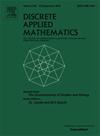Queue layouts on folded hypercubes
IF 1
3区 数学
Q3 MATHEMATICS, APPLIED
引用次数: 0
Abstract
A queue layout of a graph consists of a linear order of its vertices, and a partition of its edges into queues, such that no two edges in the same queue are nested. The queue number is the minimum number of queues required in a queue layout of . A graph is a -queue graph if . Gregor et al. in Gregor et al. (2012) showed that the -dimensional hypercube has a layout into queues for all . Pai et al. in Pai et al. (0000) gave several upper bounds when . In particular, . In this work, we generally obtain that has queue number at most for all .
折叠超立方体上的队列布局
图G的队列布局包括其顶点的线性顺序,以及将其边划分为队列,使得同一队列中的两条边不嵌套。队列号qn(G)为G的队列布局所需的最小队列数,当qn(G)≤q时,图G为q队列图。Gregor et al.(2012)在Gregor et al.(2012)中表明,n维超立方体Qn对于所有n≥1,具有n−⌊log2n⌋队列的布局。Pai et al.(0000)中的Pai et al.给出了n≤7时的几个上界。其中,qn(FQ7)≤12。本文一般得出,对于所有n≥2的情况,FQn的队列数最多为2n−2。
本文章由计算机程序翻译,如有差异,请以英文原文为准。
求助全文
约1分钟内获得全文
求助全文
来源期刊

Discrete Applied Mathematics
数学-应用数学
CiteScore
2.30
自引率
9.10%
发文量
422
审稿时长
4.5 months
期刊介绍:
The aim of Discrete Applied Mathematics is to bring together research papers in different areas of algorithmic and applicable discrete mathematics as well as applications of combinatorial mathematics to informatics and various areas of science and technology. Contributions presented to the journal can be research papers, short notes, surveys, and possibly research problems. The "Communications" section will be devoted to the fastest possible publication of recent research results that are checked and recommended for publication by a member of the Editorial Board. The journal will also publish a limited number of book announcements as well as proceedings of conferences. These proceedings will be fully refereed and adhere to the normal standards of the journal.
Potential authors are advised to view the journal and the open calls-for-papers of special issues before submitting their manuscripts. Only high-quality, original work that is within the scope of the journal or the targeted special issue will be considered.
 求助内容:
求助内容: 应助结果提醒方式:
应助结果提醒方式:


